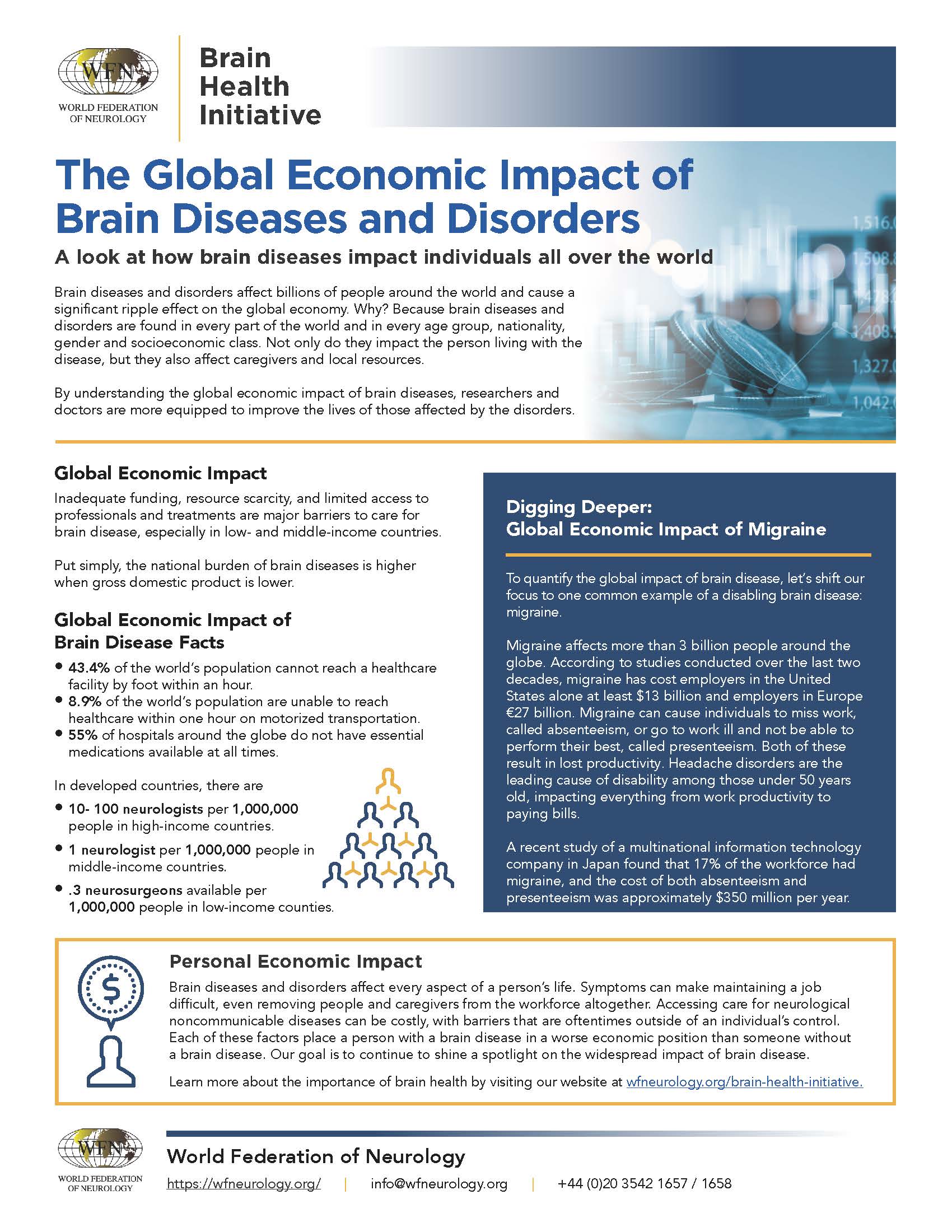The Global Impact of Brain Diseases and Disorders
How brain diseases affect the individual, society and global economies
The impact of brain disease and disorders affects society at every level. To understand the breadth of how these conditions impact economies, we first must look at access to care and specialists; investment in healthcare resources; health and wealth inequality; and local, national and international actions.
Access to Care and Treatment
At all levels–international, national and local–healthcare access is not equal. Millions of people around the world cannot access the care they need to prevent and treat neurological disorders. To identify the barriers, the World Health Organization and the World Federation of Neurology partnered to create two editions of the Atlas: Country Resources for Neurological Disorders (Atlas) ⧉ in 2004 and 2016 which compiled data from 132 countries and two territories to report on neurological resources for 94% of the world’s population.
The data show that inadequate funding, lack of specialist healthcare professionals and costs of treatments are major barriers to care for neurological disorders. Only 12% of countries report a separate budget line for neurological disorders, and the budgets are low for countries that do include it.
There are also entire regions of the world that are not served by a local hospital, leaving people without care or forcing them to travel long distances for care. One study published in Nature Medicine ⧉ found that 8.9% of the world’s population is unable to reach healthcare within one hour if they have access to motorised transportation. The same study also found that 43.3% of the world’s population cannot reach a healthcare facility by foot within one hour.
Refugees, migrants and homeless people face major barriers to accessing healthcare. The data on healthcare access does not include the estimated 26.3 million refugees or 150 million homeless people around the globe, according to the United Nations ⧉ . These populations face significant hurdles when seeking healthcare.
Another barrier people face is the inaccessibility of essential medications for neurological disorders. Countries surveyed in the Atlas were asked if hospitals had access to certain essential medications, meaning that the medicine is available at all times, at the proper dosage, at a price the community can afford and with assured quality. For example, only 55% of countries reported the availability of one or more anticonvulsants, which are used to treat epilepsy.
Inequity of the Burden of Brain Disease
A country's economic wealth is the most effective predictor of its level of healthcare availability. Economic wealth impacts the quality and quantity of hospitals, medications, technical equipment and neurological workforce. Put simply, the national burden of brain diseases is higher when national wealth is lower.
As a result, low- and middle-income countries face a disproportionate burden from neurological diseases because of lack of healthcare services, medications, preventative interventions and brain health awareness. High-income countries are able to invest more in all healthcare resources, including education surrounding nutrition and lifestyle.
Around the world, there are on average only 3.1 neurologists per 100,000 people, and low-income countries have a much smaller share. Low-income countries have no neurologists or numbers as low as 0.1 neurologists per 100,000 people compared to 7.1 per 100,000 in high-income countries.
Neurological noncommunicable disorders affect entire economies. Migraine, as an example, affects more than 3 billion people around the globe. According to studies conducted over the last two decades, migraine has cost United States employers at least $13 billion and European employers €27 billion. In addition to this impact, migraine and headache disorders are the leading cause of disability among those under 50 years of age, decreasing their participation in economic activities.
A study of a multinational information technology company in Japan found that 17% of the workforce had migraine, and the cost of both absenteeism and presenteeism was approximately $350 million per year. The study was conducted by researchers with the World Health Organization Regional Office for the Western Pacific (WHO-WPRO), the International Headache Society (IHS), and the Global Patient Advocacy Coalition.
Download our guide to learn more about the Global Economic Impact of Brain Disease
Neurological disorders impact every aspect of a person’s life, and they also have an economic impact that burdens the individual, their community, their nation and the world. To combat the burden of brain diseases and disorders, we must invest in and improve healthcare access.









